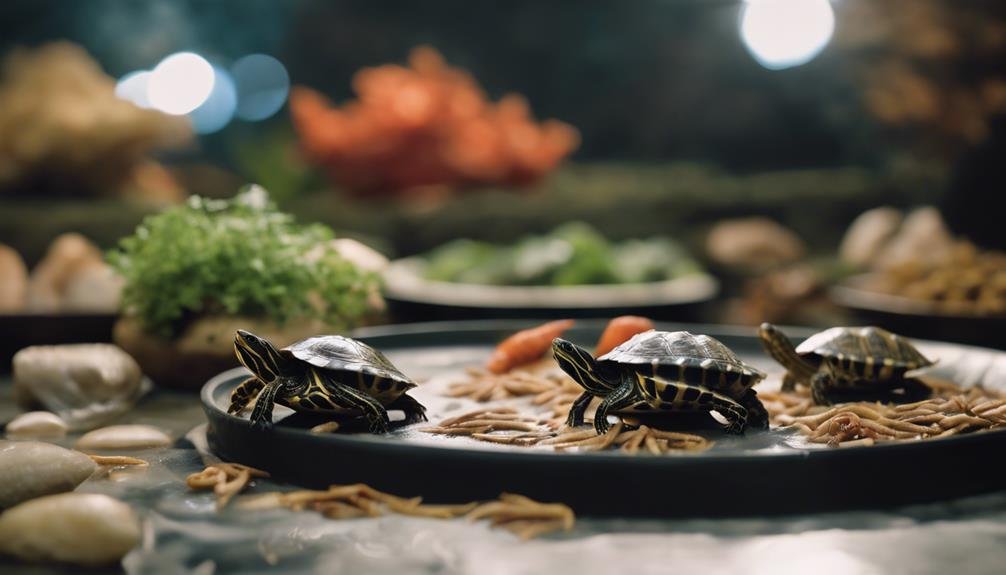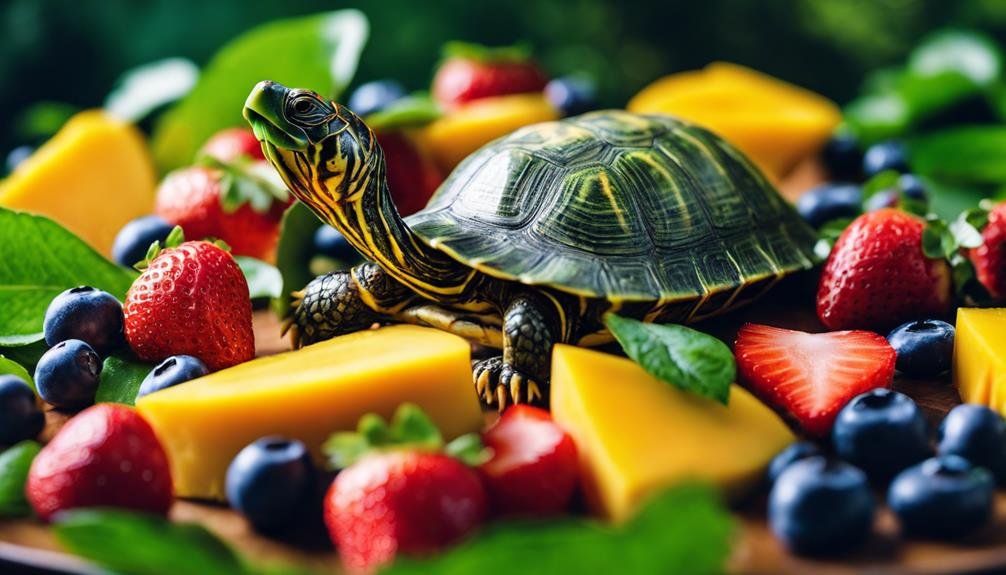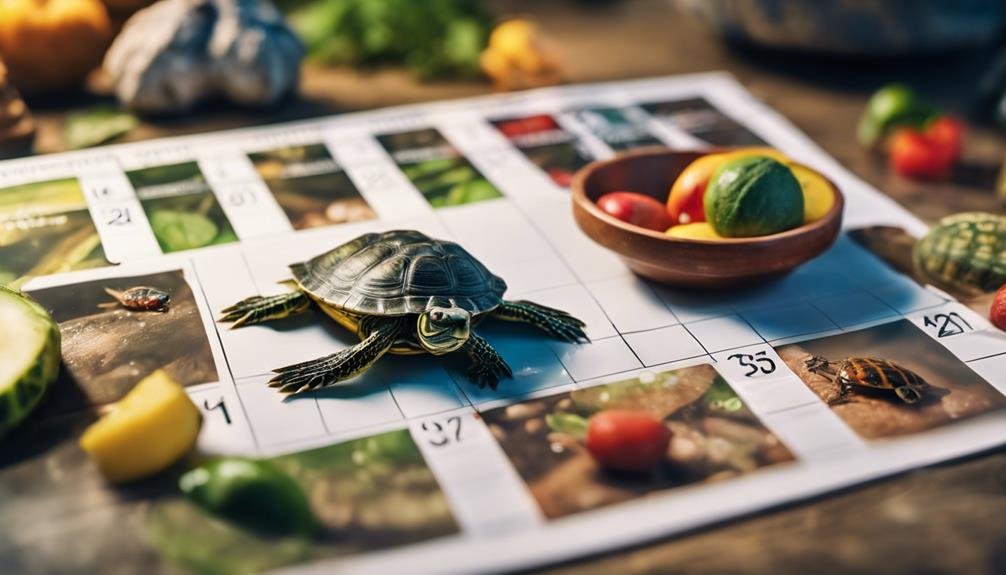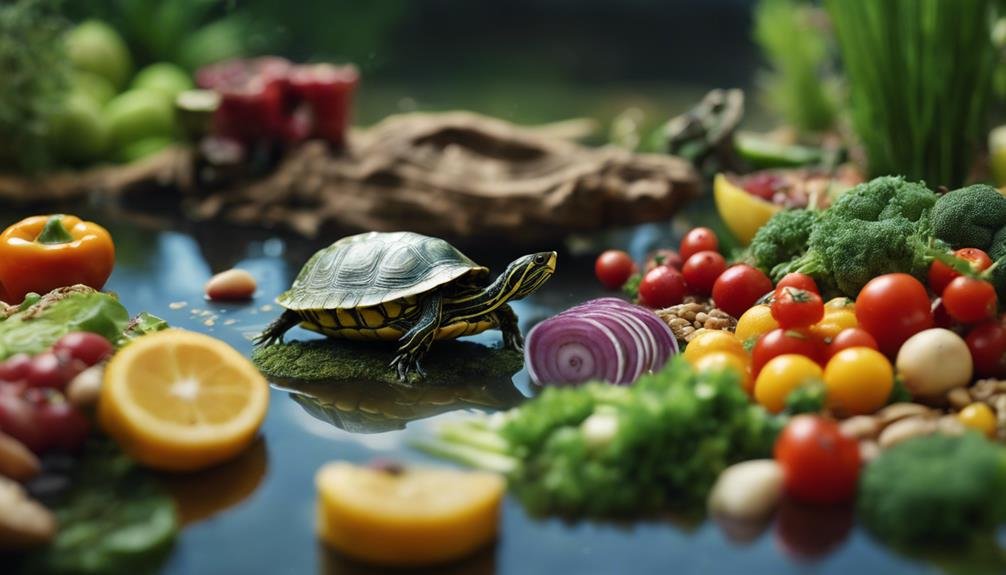If you’re dedicated to ensuring your red-eared slider thrives, understanding their dietary needs is essential. Balancing their diet with essential vegetables, quality proteins, and the occasional fruit treat isn’t just about mimicking their natural habitat—it’s about providing the nutrition they need for a healthy life. From the role of aquatic plants to the importance of turtle pellets and how to manage feeding schedules, there’s a lot to take into account. But where do you start, and how do you make sure you’re not overfeeding or neglecting vital nutrients? Stick around to uncover top recommendations that could transform your turtle’s health and happiness.
Key Takeaways
- Include aquatic plants like duckweed and water lettuce for fiber and essential vitamins.
- Offer commercial turtle pellets as a staple for balanced nutrition.
- Supplement the diet with leafy greens such as kale and dandelion greens for minerals.
- Provide animal proteins like cooked fish or shrimp for juveniles more frequently.
- Limit fruit treats to small portions of apples or berries for variety without overfeeding.
Essential Vegetables and Greens
To guarantee your red-eared slider thrives, it’s important to include essential vegetables like kale, collard greens, and squash in their diet. These aren’t just add-ons; they’re necessary for providing the vitamins and minerals your turtle needs to stay healthy. Incorporating a variety of greens, such as dandelion greens, mustard greens, and parsley, prevents your pet from getting bored and ensures they receive a balanced nutrition.
It’s a common misconception that turtles only need protein. However, red-eared sliders require a diet rich in both protein and vegetables to maintain their health. By offering a mix of these essential vegetables, you’re not just feeding your turtle; you’re giving them the diverse nutrients they need for good health. This variety is key to preventing nutritional deficiencies and promoting a vigorous, happy life for your red-eared slider.
Aquatic Plants for Nutrition
Incorporating aquatic plants such as anacharis and water hyacinth into your red-eared slider’s diet offers them essential nutrients they wouldn’t want to miss. These plants aren’t just a food source; they’re a cornerstone for maintaining a balanced diet that mirrors their natural environment. By adding these to your turtle’s menu, you’re not just feeding them; you’re enhancing their overall health and well-being.
Including aquatic plants provides numerous benefits:
- Mimics Natural Environment: It creates a more natural and familiar setting for your red-eared slider turtles, making them feel right at home.
- Promotes Overall Health: These plants are packed with fiber, vitamins, and minerals, essential for your turtle’s health.
- Adds Variety and Enrichment: Grazing on different aquatic plants keeps feeding time interesting and engaging for your turtle.
- Ensures a Balanced Diet: They help round out your turtle’s diet, ensuring they get a mix of all the essential nutrients they need.
Protein Sources and Portions


After exploring the world of aquatic plants, let’s focus on the protein your red-eared slider needs to thrive. For these aquatic turtles, a balanced diet is essential, with animal protein being a significant part. Juveniles require animal protein to make up two-thirds of their diet, while adults need it to be about half.
Safe protein sources are key. You can rely on commercial turtle or fish pellets, which are formulated to meet their nutritional needs. Invertebrates like earthworms, snails, and various insects, as well as feeder fish such as goldfish and guppies, provide excellent natural protein sources. However, it’s important to steer clear of raw meat, fish, or chicken from grocery stores, as these aren’t recommended for red-eared sliders.
Monitoring the carnivorous portion of their diet is essential to avoid overfeeding and potential health issues. Always consult a veterinarian to get guidance on appropriate protein portions and sources for your slider. Remember, providing a variety of safe protein sources will help ensure your red-eared slider maintains a balanced diet and vibrant health.
The Role of Turtle Pellets
Turtle pellets, comprising approximately a quarter of a red-eared slider’s diet, are essential for providing essential vitamins and minerals. These compact food sources aren’t just a convenience; they’re a necessity for your slider’s health and longevity. By making up 25% of your red-eared slider’s diet, turtle pellets play an important role in warding off dietary deficiencies and guaranteeing your pet receives a well-rounded nutrition.
When incorporating turtle pellets into your red-eared slider’s diet, here are a few key points to take into account:
- Essential Vitamins and Minerals: Turtle pellets are formulated to include the vitamins and minerals vital to your turtle’s health.
- Preventing Dietary Deficiencies: A consistent intake of high-quality pellets helps prevent nutritional gaps in your turtle’s diet.
- Convenience: Pellets offer a straightforward way to make sure your slider gets its necessary nutrients without the guesswork.
- Reputable Brands: Opting for pellets from reputable brands ensures your turtle is consuming a product that meets nutritional standards.
Feeding turtle pellets isn’t just about convenience; it’s about providing a consistent nutrient intake that supports the overall well-being of your red-eared slider. Remember, a balanced diet is key to a healthy, happy turtle.
Fruits as Occasional Treats


When it comes to treating your red-eared slider, not all fruits are created equal. You’ll need to know which fruits are suitable and how much to serve to keep their diet balanced and prevent health issues.
Let’s look at suitable fruit choices and the guidelines for serving sizes to make sure your turtle enjoys these treats safely.
Suitable Fruit Choices
Occasionally incorporating fruits like apples, bananas, and berries into your red-eared slider’s diet can offer them delightful treats. Given their high sugar content, it’s important to offer these fruits sparingly to avoid potential digestive issues. Always monitor your turtle’s response to these new additions to their diet and limit treats to maintain a balanced diet that prioritizes vegetables and proteins.
To help you introduce fruits safely, consider these recommendations:
- Apples (without seeds)
- Bananas (in very small amounts)
- Berries (such as strawberries or blueberries)
- Melon (as a rare treat)
Serving Size Guidelines
Understanding how much and how often to feed your red-eared slider fruits can help prevent health issues related to overconsumption. Fruits should be offered as occasional treats, not a staple in their diet, due to their high sugar content.
It’s important to limit the serving size of fresh fruits to maintain your turtle’s nutritional balance and avoid diarrhea. Fruits should only constitute a small portion of your red-eared slider’s overall diet. Avoid feeding them fruits daily to prevent disrupting their nutritional equilibrium.
Always monitor your turtle’s response to these sweet treats and adjust the frequency and amount accordingly. By doing so, you’ll make sure that your red-eared sliders enjoy the benefits of fruits without the risks that come from overindulgence.
Nutritional Supplements
In order to guarantee that your red-eared slider receives all the nutrients it needs, it’s important to mix reptile multivitamins with calcium into their diet. Optimal nutrition is the cornerstone of your turtle’s health, and integrating specific supplements ensures they don’t miss out on essential nutrients.
- Calcium Supplementation: It’s essential for the development and maintenance of a strong shell. Adding a cuttlebone to the tank offers a constant source of additional calcium. This not only supplements their diet but also provides a fun chewing activity.
- Reptile Multivitamins: Choose multivitamins that include vitamin D3 to ensure the proper absorption of calcium. This will aid in preventing metabolic bone disease, a common ailment in captive turtles.
- Cuttlebone: Easily found in the bird sections of pet stores, these can be floated in the water or affixed to the side of the tank for easy access. They serve as an excellent source of calcium.
- Diet Integration: Regularly incorporating these supplements into your turtle’s diet supports overall health and vitality.
Feeding Schedule and Tips


Creating a consistent feeding schedule for your red-eared slider is crucial to maintaining their health and preventing obesity. For adult red-eared sliders, it’s best to feed them once every three days. This frequency helps prevent overfeeding, a common issue that can lead to health problems. Pay close attention to your turtle’s body condition and adjust the feeding frequency if necessary.
You’ll want to offer a balanced diet that includes aquatic plants, vegetables, and prey items to make sure they receive all the necessary nutrients. It’s also important to observe your turtle’s hunger cues and adjust their feeding schedule based on their individual needs. Some days they might be hungrier than others, and that’s okay. Just remember to feed them as much as they can consume in 15 minutes to prevent waste and overfeeding.
What Foods Can Help Increase the Lifespan of a Red Eared Slider?
To increase the red eared slider lifespan, information about their dietary needs is crucial. Foods like spinach, carrots, and dandelion greens are rich in nutrients and can help boost their immunity and overall health. Additionally, small amounts of fish and shrimp can be added for protein and variety.
Frequently Asked Questions
What’s the Best Food for a Red Eared Slider?
You’re wondering what’s best to feed your red-eared slider, right?
Start with aquatic turtle pellets as a core part of their diet. Don’t forget to mix in some prey items like earthworms, crickets, and aquatic snails for variety.
Leafy greens, including collard greens and kale, are essential for nutrients. You can also add in aquatic plants and veggies like carrots and squash to keep their meals interesting and balanced.
What Not to Feed Red-Eared Sliders?
You shouldn’t feed your red-eared slider toxic foods like avocado, citrus, mushrooms, onions, and tomatoes. Also, avoid giving them raw meat, fish, or chicken from grocery stores.
Make sure not to include toxic plants like rhubarb, azaleas, and oleander in their diet. Don’t give them dairy products, as they’re hard for turtles to digest.
Lastly, keep harmful additives like salt, sugar, and spices out of their meals.
What Should I Get for My Red Eared Slider?
You should get high-quality commercial turtle pellets as the base of your red-eared slider’s diet.
Don’t forget to add in some live prey like earthworms, crickets, and aquatic snails for protein.
Leafy greens, such as collard greens and kale, along with aquatic plants like anacharis, will provide essential nutrients.
Including vegetables like carrots and squash won’t only diversify their diet but also offer some enrichment.
What Is the Most Popular Food for Turtles?
You’re probably wondering about the most popular food for turtles, right?
Well, aquatic turtle pellets take the top spot because they’re packed with the essential nutrients turtles need. But don’t just stop there; mixing in prey items like earthworms and crickets, along with leafy greens such as collard greens, will guarantee your turtle’s diet is both varied and nutritious.
Adding in some aquatic plants and veggies like carrots can also enhance their health.
Conclusion
In sum, you’ll want to mix it up with essential veggies and greens, aquatic plants, and the right portion of protein to keep your red-eared slider thriving.
Don’t forget, turtle pellets play an important role in their diet, and fruits should only be occasional treats. Consider adding nutritional supplements if needed.
Stick to a feeding schedule that suits your turtle’s needs, and always keep an eye on their appetite to avoid overfeeding. Consulting a vet can also provide tailored advice for your pet’s health.


